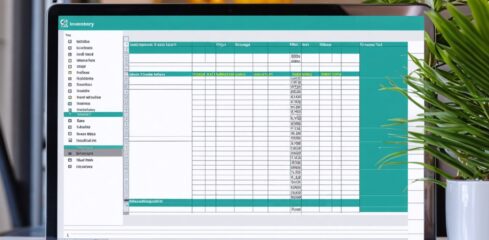If your business has vast numbers of products flowing in and out of your warehouses, that’s often an excellent sign. It means you’re running a flourishing business — and it also means you need practical tools to inform yourself about what inventory you have and how it fluctuates over time. Cycle counting offers an attractive solution to help you manage your inventory.
Basics of Cycle Counting
What is cycle counting in inventory management? It is a method of counting the products you have in stock to make your inventory operations more effective.
In inventory management, you often perform an annual count that includes every item you have in stock. This necessary process can be time-consuming and disruptive, however. Cycle counting provides a more efficient alternative.
In the cycle counting process, a business chooses regular, more frequent intervals at which to count its inventory. Under this system, you won’t count all your stock at once. Instead, you’ll break it into more manageable sections — perhaps every day, week or month. That way, much of your staff can focus on other core activities while a few employees perform cycle counting. Once they’ve finished, they start all over again.
Cycle counting inventory offers a valuable alternative to annual counting in various ways. One danger of checking inventory only annually is that your stock can change substantially from one year to the next. Consequently, you may encounter significant discrepancies or losses. Cycle counting allows you to keep a more fixed eye on your stock so you’ll always have a reliable idea of what products you should have on hand.


How Is Cycle Counting Used in Logistics?
Is cycle counting used in logistics? And how can a logistics company use cycle counting?
This process has a few different applications in logistics and inventory management:
- Ensuring consistency: Cycle counting in the logistic industry provides consistent data. If you count your inventory only once per year, you may not give much weight to an aberrant number because so much can change in twelve months. If you count certain products every week, though, you’ll have more consistent data to use in analysis and forecasting.
- Preventing shrinkage: One hazard of performing only a yearly inventory count is that some of your products could walk off without you noticing for months. If employees are aware you only rarely check your inventory, thefts may become more likely. Or, you may experience shoplifting and not realize the problem until much later. Cycle counting lets you keep a closer eye on your numbers so you can be alert for shrinkage.
- Ensuring scalability: You need your inventory management processes to grow with your business. For instance, an annual count is often feasible with smaller inventory levels. When you have fewer products, counting everything you have in stock doesn’t take much time. But as your business develops, stopping to count all your product may become impossible. Choosing shorter cycle intervals that you can maintain as your business grows means you can remain efficient even as you expand.
- Improving customer satisfaction: Infrequent inventory counting can lead to unhappy customers. If you don’t know how much of each product you have in stock, you may frequently run out, leaving consumers frustrated. Cycle counting in your warehouse keeps you on top of your numbers, so you’ll know when to order more to keep your clientele satisfied and loyal.
Cycle Counting Methodology
Cycle counting can use different methodologies, so you may choose one depending on your business’s particular setup and requirements. Below are a few of the most common methods:
- Control group cycle counting: Control group cycle counting involves choosing a few items to act as a control group and counting them many times over a short interval. Through multiple countings, you’ll get a sense of where and how you’re making errors, and you can use that data to improve your processes.
- Random sample cycle counting: Random sample cycle counting is useful when you have many styles of similar items. With this method, you’ll choose a certain number of representative products to count during each cycle. This technique’s benefit is that you can focus on a few items, leaving the bulk of your inventory undisturbed.
- ABC cycle counting: ABC cycle counting often works via the Pareto principle from economics — the idea that 80% of outcomes result from 20% of causes. Eighty percent of your losses, for instance, might come from 20% of your valuable items. Under this system, you’ll classify your products into categories A, B and C by their value. You’ll then use these categories to count the high-value items more frequently than the lower-value ones. You might also create divisions based on how regularly you handle or move different products.


Logistic Cycle Counting Best Practices
Cycle counting is highly advantageous for your business, and you’ll want to implement the following best practices to get the most value from it.
- Count one group at a time: Once you’ve chosen your cycle groups, stick to counting one at a time. Focusing your attention prevents confusion and allows you to move through your inventory faster.
- Account for seasonal popularity: Some of your items may be more popular at certain times than others — such as heavy coats in the fall and swimsuits and sunglasses in summer. You may want to arrange your cycles so you have each item counted at the height of its popularity. That way, you can be sure you have enough in stock when demand is high.
- Perform targeted assessments: Performing targeted inspections allows you to focus on specific items. For instance, you might choose a few more expensive or high-priority categories and count those sections in short, repeated cycles. That way, you’ll make sure nothing goes amiss between annual inventories.
- Maintain a dedicated team: One of the benefits of cycle counting is that it allows you to devote specialized employees to the process. If your whole operation stops every year so everyone can count inventory, employees unfamiliar with the process may make mistakes or fall behind. Tallying up smaller batches of products in cycles means you can set up a dedicated inventory team. As team members learn the process thoroughly, they will become skilled and rapid, ensuring efficiency and accuracy.
Using Finale Inventory for Inventory Management
When you use Finale Inventory for your cloud-based logistics management, you gain several advantages:
- Convenience: Our centralized inventory tracking makes our system exceptionally quick and easy to use, so your cycle tracking data will be readily accessible for analysis. Our system also contains automated tools for stock audits to streamline cycle counting and notify you of potential inventory discrepancies.
- Live data: Finale Inventory provides up-to-the-minute data for everyone with access, so you’ll always make decisions with the most current information in mind. You can input cycle tracking numbers and make them available to everyone at once.
- Security: Part of the goal of using cycle tracking is to minimize losses, so you need a way to keep your data secure along with your inventory. Finale Inventory assures your data’s safety and integrity against security breaches.
- Minimal costs: Finale Inventory requires few operating or maintenance costs, so you can manage your cycle counting while maintaining peace of mind about its impact on your budget.


How to Combat the Competition With Finale Inventory
When you need to improve your inventory management with convenient, efficient cycle counting, work with Finale Inventory to gain an edge over your competitors. By using Finale Inventory, you’ll gain fast, adaptable, scalable cloud-based software that offers inventory management, order management, multi-warehouse support and many other functionalities to make your business more productive and profitable.
All our plans are convenient month-to-month options, so you’ll have manageable commitments and be free from startup and setup costs. We also provide training and consulting free with your trial and include them in each paid plan. And because we know every inventory management application is unique, our experienced, trustworthy domain experts partner with you to craft a solution that meets your specific business needs.
Schedule a demo or start your free trial today.







